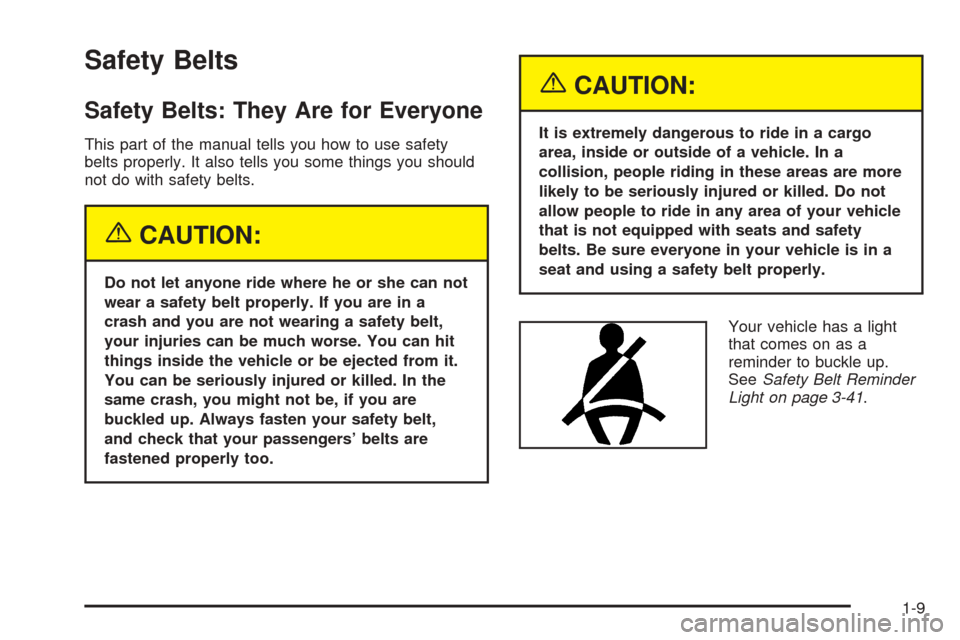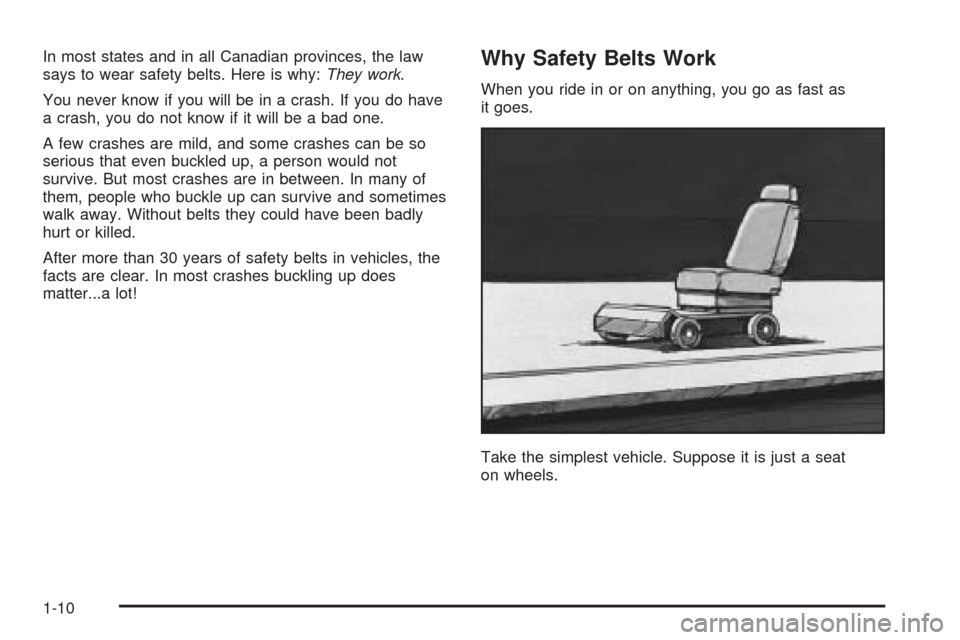CADILLAC CTS 2004 1.G User Guide
Manufacturer: CADILLAC, Model Year: 2004, Model line: CTS, Model: CADILLAC CTS 2004 1.GPages: 454, PDF Size: 2.87 MB
Page 11 of 454

But don’t have a seatback reclined if your vehicle
is moving.
{CAUTION:
Sitting in a reclined position when your vehicle
is in motion can be dangerous. Even if you
buckle up, your safety belts can not do their
job when you are reclined like this.
The shoulder belt can not do its job. In a
crash, you could go into it, receiving neck or
other injuries.
The lap belt can not do its job either. In a crash
the belt could go up over your abdomen.
The belt forces would be there, not at your
pelvic bones. This could cause serious internal
injuries.
For proper protection when the vehicle is in
motion, have the seatback upright. Then sit
well back in the seat and wear your safety
belt properly.
1-5
Page 12 of 454

Head RestraintsAdjust your head restraint so that the top of the restraint
is closest to the top of your head. This position
reduces the chance of a neck injury in a crash.
The front seat head restraints move up and down.
Press the button located at the bottom of the head
restraint to raise or lower the head restraint. The head
restraints tilt forward and rearward, also.
The rear seat head restraints work the same as the
front head restraints. You can remove the rear
head restraints, also. Press the button located on top of
the seatback and pull up on the head restraint to
remove it.
1-6
Page 13 of 454

Rear Seats
Split Folding Rear Seat
Your vehicle may have a split folding rear seat. A split
folding rear seat allows you to carry long cargo by
folding down part or all of the rear seat. Before you can
fold the rear seatback, you need to unlatch the center
seatbelt buckle.
Use the following steps to lower one or both of the
rear seatbacks:
1. Insert a tool with a
small tip into the slot
as shown to unlatch
the seatbelt buckle.
Then move the belt to
the side so it is not
in your way.2. There is a tab located
on the outboard sides
of the seatback.
Pull forward on the tab
to unlock the seatback.
3. Fold the seatback down. This will allow you direct
access to the trunk.
4. Repeat Steps 2 and 3 to fold down the
other seatback.
1-7
Page 14 of 454

{CAUTION:
If the seatback is not locked, it could move
forward in a sudden stop or crash. That could
cause injury to the person sitting there. Always
press rearward on the seatback to be sure
it is locked.
{CAUTION:
A safety belt that is improperly routed, not
properly attached, or twisted will not provide
the protection needed in a crash. The person
wearing the belt could be seriously injured.
After raising the rear seatback, always check
to be sure that the safety belts are properly
routed and attached, and are not twisted.To return the seatback to the upright position,
do the following:
1. Lift the seatback up and push it back into place.
2. Reconnect the center
safety belt latch plate to
the buckle as shown.
3. Make sure the seatback is locked into place by
pushing and pulling on it.
4. Repeat Steps 1 and 3 for the other seatback.
When the seatback is not in use, it should be kept in
the upright, locked position.
1-8
Page 15 of 454

Safety Belts
Safety Belts: They Are for Everyone
This part of the manual tells you how to use safety
belts properly. It also tells you some things you should
not do with safety belts.
{CAUTION:
Do not let anyone ride where he or she can not
wear a safety belt properly. If you are in a
crash and you are not wearing a safety belt,
your injuries can be much worse. You can hit
things inside the vehicle or be ejected from it.
You can be seriously injured or killed. In the
same crash, you might not be, if you are
buckled up. Always fasten your safety belt,
and check that your passengers’ belts are
fastened properly too.
{CAUTION:
It is extremely dangerous to ride in a cargo
area, inside or outside of a vehicle. In a
collision, people riding in these areas are more
likely to be seriously injured or killed. Do not
allow people to ride in any area of your vehicle
that is not equipped with seats and safety
belts. Be sure everyone in your vehicle is in a
seat and using a safety belt properly.
Your vehicle has a light
that comes on as a
reminder to buckle up.
SeeSafety Belt Reminder
Light on page 3-41.
1-9
Page 16 of 454

In most states and in all Canadian provinces, the law
says to wear safety belts. Here is why:They work.
You never know if you will be in a crash. If you do have
a crash, you do not know if it will be a bad one.
A few crashes are mild, and some crashes can be so
serious that even buckled up, a person would not
survive. But most crashes are in between. In many of
them, people who buckle up can survive and sometimes
walk away. Without belts they could have been badly
hurt or killed.
After more than 30 years of safety belts in vehicles, the
facts are clear. In most crashes buckling up does
matter...a lot!Why Safety Belts Work
When you ride in or on anything, you go as fast as
it goes.
Take the simplest vehicle. Suppose it is just a seat
on wheels.
1-10
Page 17 of 454

Put someone on it. Get it up to speed. Then stop the vehicle. The rider
does not stop.
1-11
Page 18 of 454

The person keeps going until stopped by something.
In a real vehicle, it could be the windshield...or the instrument panel...
1-12
Page 19 of 454

or the safety belts!
With safety belts, you slow down as the vehicle does.
You get more time to stop. You stop over more distance,
and your strongest bones take the forces. That is why
safety belts make such good sense.
Questions and Answers About
Safety Belts
Q:Will I be trapped in the vehicle after an accident
if I am wearing a safety belt?
A:Youcouldbe — whether you are wearing a safety
belt or not. But you can unbuckle a safety belt,
even if you are upside down. And your chance of
being conscious during and after an accident,
so youcanunbuckle and get out, ismuchgreater
if you are belted.
Q:If my vehicle has airbags, why should I have
to wear safety belts?
A:Airbags are in many vehicles today and will be in
most of them in the future. But they are
supplemental systems only; so they workwith
safety belts — not instead of them. Every airbag
system ever offered for sale has required the use of
safety belts. Even if you are in a vehicle that has
airbags, you still have to buckle up to get the most
protection. That is true not only in frontal collisions,
but especially in side and other collisions.
1-13
Page 20 of 454

Q:If I am a good driver, and I never drive far from
home, why should I wear safety belts?
A:You may be an excellent driver, but if you are in an
accident — even one that is not your fault — you
and your passengers can be hurt. Being a good
driver does not protect you from things beyond your
control, such as bad drivers.
Most accidents occur within 25 miles (40 km)
of home. And the greatest number of serious
injuries and deaths occur at speeds of less than
40 mph (65 km/h).
Safety belts are for everyone.
How to Wear Safety Belts Properly
This part is only for people of adult size.
Be aware that there are special things to know about
safety belts and children. And there are different
rules for smaller children and babies. If a child will be
riding in your vehicle, seeOlder Children on page 1-29
orInfants and Young Children on page 1-32. Follow
those rules for everyone’s protection.
First, you will want to know which restraint systems your
vehicle has.
We will start with the driver position.
1-14